Counting environmental impacts using attributional and consequential approaches

Author : David Ekchajzer
Reviewers : Jacques Combaz and Hubblo's team
Acknowledgments : Adeline Agut, Bruno Thomas
Introduction
Environmental impacts are physical phenomena taking place within the biosphere. They can be localized to particular areas (land use, air pollution, etc.) or global (contribution to global warming, depletion of abiotic resources, etc.). These environmental impacts can be assessed using physical measuring instruments (with a carbon dioxide sensor, for example). This is the case for soil, air or water pollution, when directly measured on ecosystems. These impact measurements enable us to understand past and present environmental and physical constraints.
However, by characterizing only phenomena that take place inside the biosphere, they make it difficult to manage consumption, production or public policies, which are socio-economic phenomena that take place within the technosphere.
The biosphere corresponds to all terrestrial ecosystems present on the lithosphere (earth), atmosphere (air) and hydrosphere (sea). The technosphere corresponds to the part of the biosphere modified by human activities.
This is where environmental accounting comes in. It makes it possible to match socio-economic realities (a product, a service, a unit of currency, an action, a policy, etc.) with a physical materiality characterized by environmental impacts.
This materiality is expressed in physical units: kgCO2eq. for contribution to global warming, m3 for water depletion or kg for land transformation (see PEF1). This suggests that the values produced by environmental accounting are of the same nature as those produced by physical measuring instruments such as a CO2 sensor, a graduated container to evaluate m3 or a weighing scale to evaluate kg.
However, when used in the context of environmental accounting, these units are intended to describe not only physical realities, but also socio-economic ones. Indeed, associating environmental impacts with socio-economic realities is not a neutral approach, but rather one of accounting that follows established technical rules that are part of modeling paradigms (logical and political principles). It is these principles that define the way in which human activities in the technosphere and environmental impacts in the biosphere are linked.
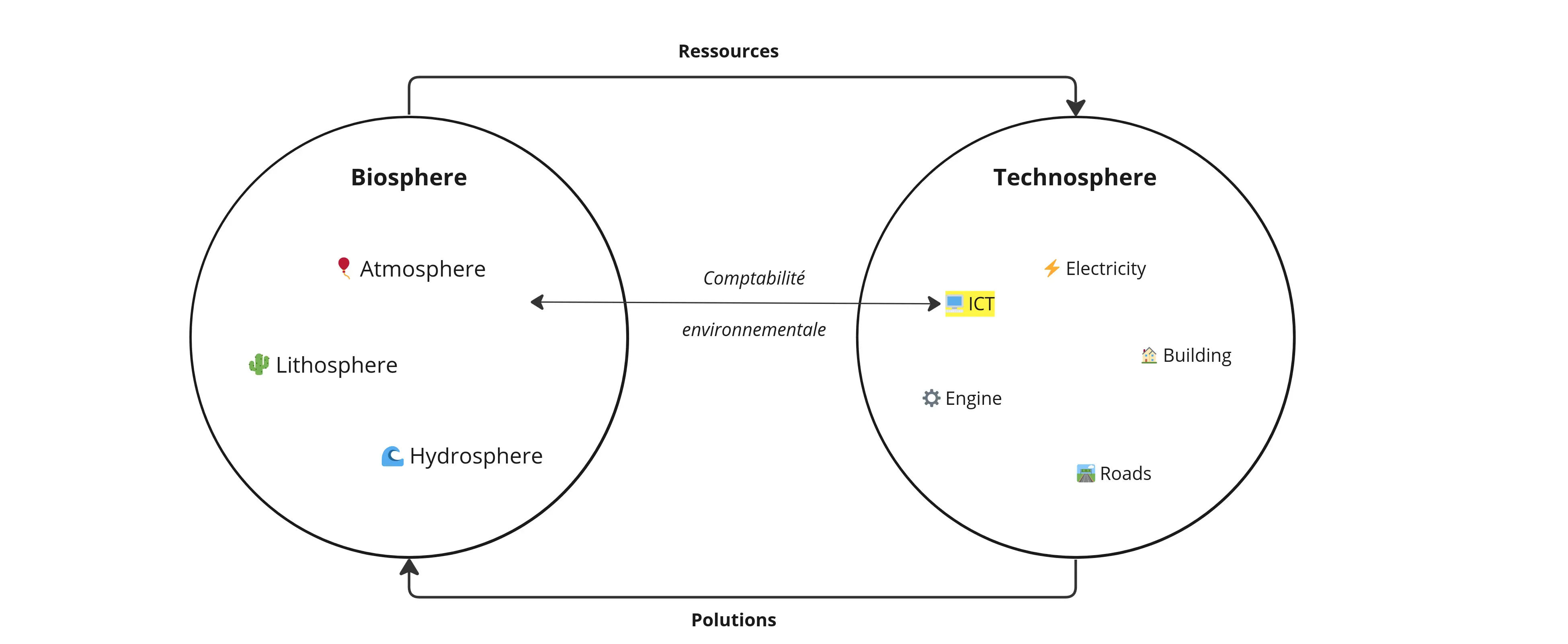
Several paradigms exist to establish this link. Each paradigm has its own usefulness, and is based on its own methodological principles. In this article, we present three major modeling paradigms: attributional, short-term consequential and long-term consequential.
This article was written as part of the life cycle assessment of Iroco, an eco-designed e-mail service. The environmental impact of e-mail is a recurring topic of conversation in the field of digital responsibility, to the point where it sometimes irritates environmental assessment practitioners. While its impact is probably overestimated by the public, its fundamental nature in our digital uses makes it an excellent case study for understanding how to change them. This is the approach taken by Iroco. After proposing an eco-designed mail service based on a number of green software good practices, they decided to go beyond efficiency and propose functionalities that would modify usage, encouraging users to adopt more sustainable practices. To understand the relevance of the imagined levers, they decided to carry out an environmental impacts study. The complete study can be downloaded here (in french). Over the coming weeks, you'll find a series of articles on Iroco's blog detailing the implementation and results of the study. What's special about this study is that it uses the three approaches mentioned above to provide the most comprehensive answer to Iroco's questions. This article uses this study to illustrate the three paradigms mentioned above.
In Life Cycle Assessment (an environmental accounting method), the activities evaluated are described by a functional unit (FU). For the sake of clarity, in this article we will refer to the activity evaluated in the context of environmental accounting as a FU.
The functional unit is the unit of measurement used to assess the service provided by the product or service in question. In the same way that a consumer compares the price of two fruits on a per kilo basis, to compare the environmental impacts of two products, the impacts are reduced to a common unit of measurement.
Attributional paradigm
Attributional analysis aims to answer the question: "What share of the total impacts of my system can be attributed to the Functional Unit?". The aim here is to characterize the impacts of the FU by attributing to it a share of the overall impacts of a system considered in a status quo (i.e. frozen) situation. In an attributional method, the sum of the impacts of the functions provided by a system must be equal to the system's impact. For example, to assess the impact of e-mails, we associate them with a share of the impact of the mail service, so that the sum of the impacts of the e-mails is equal to the impact of the mail service.
A_LCA(SYSTEM) = SUM(A_LCA(FU))
The attributional paradigm is the one used in the vast majority of environmental assessments, particularly in studies relating to digital services. It is also the basis for GHG Protocol, which aims to allocate greenhouse gas emissions to entities in a value chain, or Attributional LCA (A-LCA), which aims to allocate environmental impacts to a product or service according to several impact categories. It was used in a study published by ADEME in 2016, which concluded that the lifecycle impact of a 1 MB e-mail was 19 gCO2eq.2

The pie chart represents all the impacts of a system. An attribution method associates a share of these impacts with the functional unit under consideration. In a status quo situation, the circle is not modified by the FU.
To determine the share of system impacts to be associated with the FU, we follow the physical links (energy and material) required to implement the FU until we arrive at environmental impacts. In other words, we include the impact of a resource if it is "physically" mobilized as part of the life cycle of the product or service being evaluated. In the case of e-mail, for example, this means starting with the terminals (TIER 1), network (TIER 2) and datacenters (TIER 3) mobilized for sending and e-mail. Then, working backwards and forwards, we include the physical links implied by each of these resources to arrive at the environmental impacts. In practice, to avoid describing all the physical flows exhaustively, we use impact factors to factorize the environmental materiality of a resource.
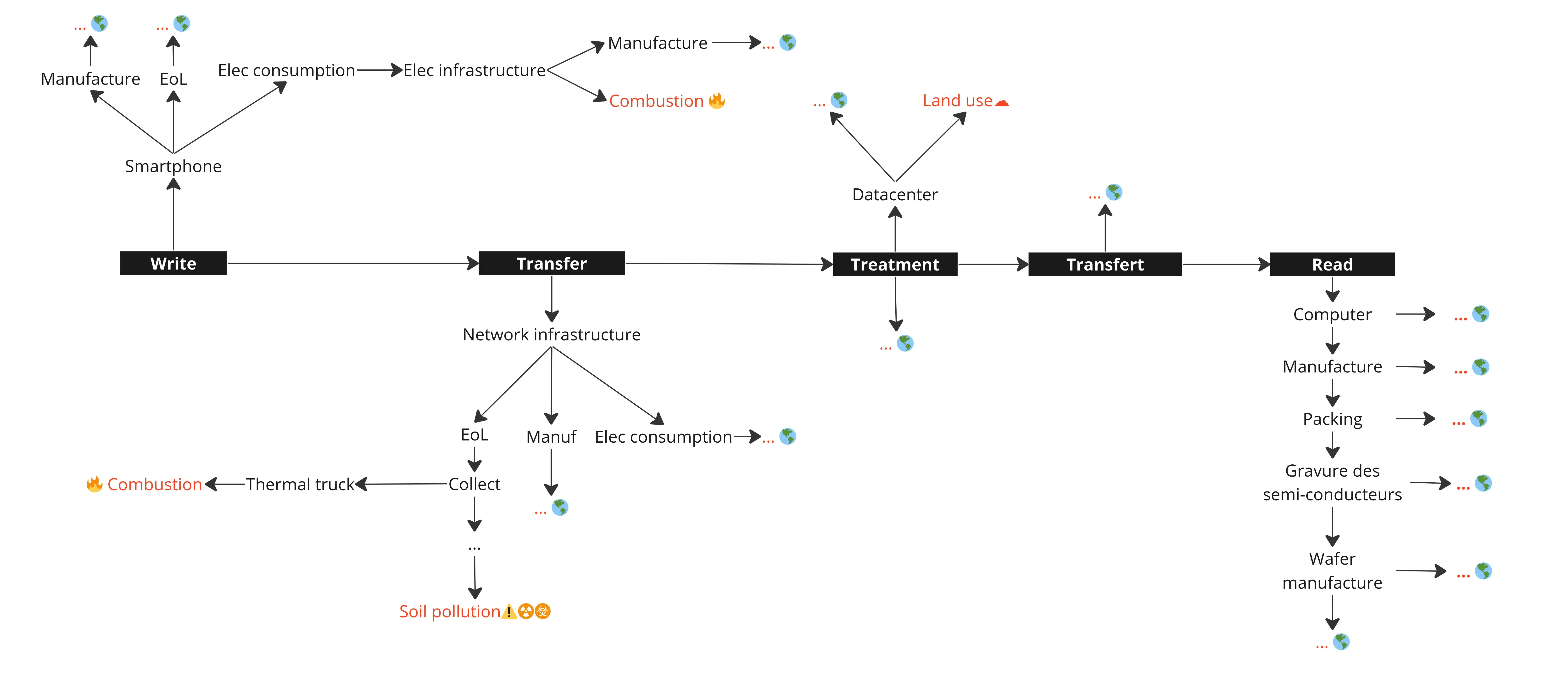
Most of the systems involved in the life cycle of a product or service serve other products or services. They therefore produce several functions which are sometimes not commensurable (i.e., their quality cannot be directly qualified by the same unit of measurement). This type of system is known as multifunctional. Digital services are particularly well-suited to multifunctional systems, thanks to the high degree of mutualization of infrastructures and equipment. The Tier 3 mobilized to deliver an e-mail are used to deliver other e-mails, but also for countless other services that are not commensurable with each other (for example, a payment service is not comparable to a streaming service). In this case, the attribution paradigm involves assigning a fraction of the system's impacts to the FU under consideration. To partition these impacts between the different functions provided by a multifunctional system, we use allocation keys.
An allocation key is used to distribute the environmental impacts of a system involving multiple functions.
The allocation key can be physical: weight, volume, time, etc. The allocation key can be socio-economic: price, symbolic value, etc.
Although the justifications for the use of certain allocation rules are partly objectivable, particularly where physical criteria are concerned, they are very often a matter of subjective or even political choice, whether explicit or implicit. Indeed, allocation rules reflect, in particular, the way in which stakeholders wish to distribute environmental responsibilities within a value chain. In the case of mail, for example, how should network impacts be partitioned? There are several possibilities: depending on the quantity of data transmitted, considering only the number of e-mails, or the importance of usage. A major limitation lies in the very great sensitivity to the choice of allocation rule (this idea will be the subject of a future article) and in the fact that, in many cases, different rules may be justified.
The advantage of the attributional approach is that it makes it possible to associate an environmental materiality with the entire technosphere, while assigning responsibilities to all the resulting impacts. It therefore makes it possible to define budgets or to identify the entities who are most dependent on environmental impacts in a value chain, the degree of dependence being partly determined by the allocation rules. However, this approach does not fully identify the physical and socio-economic mechanisms induced by the implementation of the FU, since it requires reasoning in a frozen system. Nor does it take into account changes in the technosphere (changes in quantities produced and/or consumed, production processes, etc.).
Following an attributional approach, and with the assumptions retained, the Iroco study evaluates the greenhouse gas emissions attributable to one week's use of a mailbox at 63.2 gCO2eq.
Consequential paradigm
In contrast to the attributional approach, the consequential paradigm identifies the impacts resulting from the changes induced by the FU. It allows us to answer the question "What is the environmental impact induced by the implementation of the FU?". In other words, it differentiates between a world in which FU has been implemented and a hypothetical world in which FU has not. In this approach, we are only interested in the post-implementation effects of the FU5 , whereas the attributional paradigm will also be interested in the impacts of the resources that were necessary for its implementation and that took place prior to it.
Theoretically, this paradigm is supposed to describe the physical and socio-economic consequences induced by the implementation of an additional FU. It can therefore be used to answer questions relating to an action (for example, what is the impact of charging an electric vehicle at 4pm, or more generally, what is the impact of electrifying 80% of the vehicle fleet by 2040).

The pie chart represents all the impacts of the system at a given time. A consequential method is used to determine the changes in impacts, represented here by the arcs of the circle (decrease or increase in impacts).
In practice, the aim is to follow the consequences of FU implementation step by step, until we arrive at environmental consequences. In other words, an impact is included in the inventory if it had not occurred without the FU.
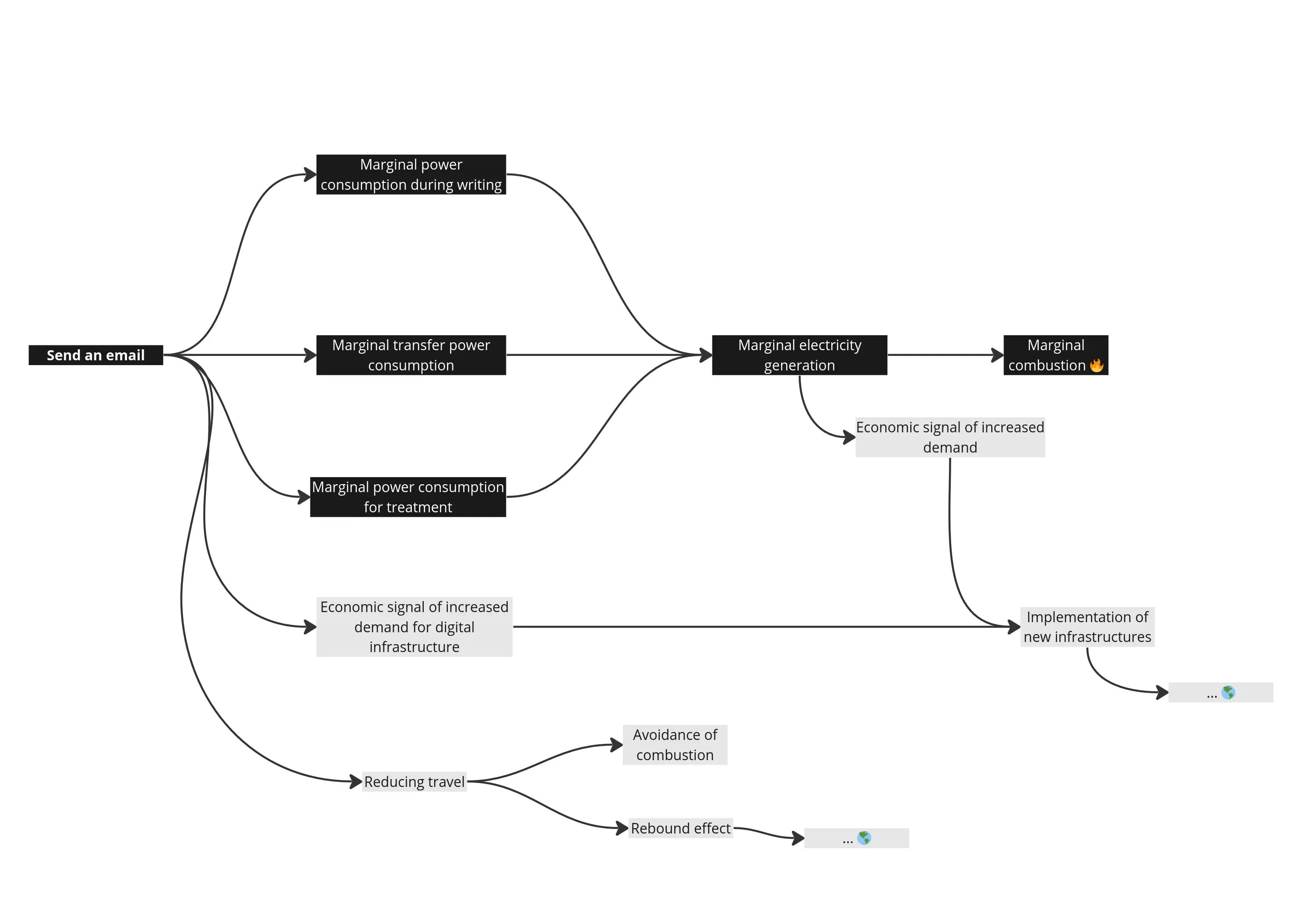
As with the attributional method, it is possible to use consequential impact factors that characterize the environmental consequences of an action. There are considerably fewer consequential impact factors available, particularly in the digital sector, where no database provides sector-specific factors. This is one of the reasons why this paradigm is rarely used, even to answer questions relating to the evaluation of a change and which therefore fall within the consequential paradigm. The attribution approach is therefore often used as a substitute, either consciously or unconsciously, with no guarantee of reliability (see section particular case).
By definition, the consequential paradigm does not take into account impacts linked to the implementation of existing infrastructures, since only post-FU consequences are considered. This approach therefore does not allow us to reason about past environmental impacts, but only about future ones. It is therefore not suitable for defining environmental responsibilities, but rather as a steering tool for achieving environmental objectives.
There are two forms of consequential approach: short-term consequential (or "marginal approach") and long-term consequential. These two forms are opposed when it comes to taking into account the change in production capacity induced by the FU. In practice, however, the two forms can be combined.
Short-term consequential paradigm
The short-term consequential or marginal approach looks at the environmental impacts directly induced by a marginal change in consumption or production (for example, the impacts of an additional unit produced). In this approach, we look at the "short-term" consequences of implementing the FU (over-consumption of energy, materials, etc.), in the sense that, as there is no time to adapt to this change, infrastructures are considered to be constant.
Let's look at the consequence graph again. In this approach, only marginal consequences are considered (in black). For this service, it's mainly the energy consumption of the equipment mobilized when an e-mail is sent:
- The sending terminal during writing and sending, and the receiving terminal when receiving and reading the e-mail
- Network equipment during data transfer
- The datacenter during e-mail processing.
Since this is a marginal approach, only the marginal power consumption induced by sending the e-mail is considered. To determine marginal consumption, we ask ourselves what electricity consumption would have been if the e-mail had not been sent, and compare it with the situation in which the e-mail was sent (reference situation).
Example for the IP network
In the case of the network, for example, we only consider the power consumption induced by the addition of a certain amount of data transferred over the network. As shown by Malmodin & al. (2020)8 , the power consumption of digital networks is not linearly related to the amount of data transferred: they behave like an affine function (of the type a*x+b). To maintain a high level of availability, a significant proportion of power consumption is fixed ("b"), i.e. it is consumed regardless of the amount of data transferred. We therefore do not include this part in the marginal approach. The other part of power consumption is dynamic, and depends linearly on throughput (the amount of data transferred over a unit of time, "a*x"). The marginal consumption of the network depends only on the coefficient "a". In fact, a variation "dx" in the amount of data transferred induces an excess power consumption of "a*(x+dx) + b - (a*x+b) = a*dx". This is the part considered in the marginal approach.
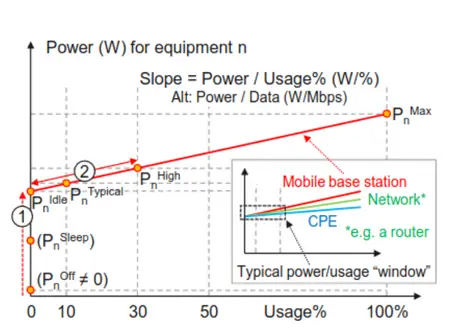
Marginal impact of electricity
Once the marginal electricity consumption has been identified, we need to determine the impact associated with this additional unit of energy consumed on the power grid. In other words, we want to know the difference in impact between a world in which we would have consumed this unit and a world in which we would not have consumed this unit.
We can't use an approach that averages the impact of the electricity mix, because not all power plants will increase their output uniformly, but one power plant will produce this additional unit of electricity. To determine the marginal impact, we need to identify which energy source is going to be mobilized to meet this demand, and identify the impact of producing one unit of energy from this source.
To determine this, we need to look at how the power grid works, and more specifically at the "merit order" mechanism (this explanation is valid for the European electricity system, other mechanisms might be implemented elsewhere). According to this mechanism, the power plant with the lowest marginal cost (monetary cost associated with the production of a unit of electricity) will respond to additional demand, among the power plants that have not reached their maximum load capacity. This power-plant is known as the marginal supplier. The power sources with the lowest marginal cost are also the plants with the lowest marginal greenhouse gas emissions. The marginal impact factor depends on the technology of the marginal supplier. For example, for renewable and nuclear power, it will be very low, say 0 gCO2eq / kWh. This is because the impacts of these energy sources derive mainly from the manufacture and end-of-life of infrastructure. 0 gCO2eq / kWh remains a simplification, because in reality the marginal impact should include the production of nuclear fuels or the various electrical consumptions required to operate the power grid and infrastructure. Conversely, for a coal-fired power plant, the marginal impact is around 1000 gCO2eq / kWh.
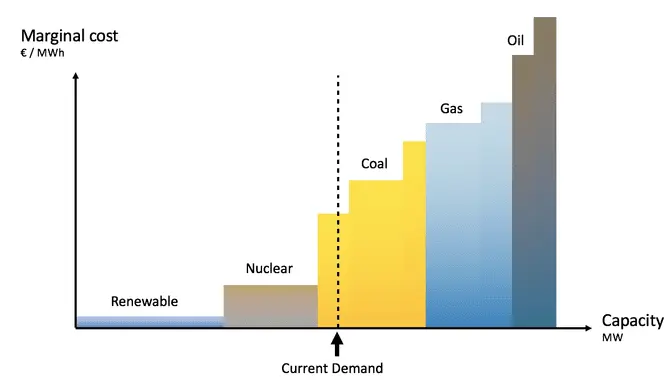
The Iroco study proposes an approach (based on dated data, the only ones available at the time of the study) for determining the marginal impact of electricity as a function of time.
Using this marginal approach and its assumptions, the study evaluates the marginal greenhouse gas emissions of one week's use of a mailbox at 0.20 gCO2eq. As might be expected, the impact of the mail service is much lower than for the attributional approach (almost 300 times lower). This is due to the fact that this approach does not take into account the impacts of manufacturing, distribution and end-of-life, nor the impacts of the fixed power consumption of network and infrastructure equipment.
The study shows that the main environmental impacts of e-mail do not lie in the direct consequences of sending it, but rather in the entire value chain involved in its operation. Focusing on the impact of e-mails via a short-term consequential approach does not allow us to grasp all the impacts implied by the existence of this digital service. The same applies to most digital services.
Long-term consequential paradigm
The long-term consequential approach is concerned with changes over longer timescales, typically enabling infrastructures and suppliers to adapt their equipment (capital) to variations in demand. It therefore includes transformations in the socio-economic system resulting from the implementation of FU. It addresses the indirect effects of FU (rebound effects, substitution, induction effects, etc.). This approach makes it possible to take into account the creation of new infrastructures or their dismantling.
Since a wide variety of consequences can be considered in this approach, the selection of those to be included depends very much on the question being asked, or the sensitivity of the practitioners conducting the study. Moreover, some of the consequences that can be identified are simply not quantifiable. When this approach is implemented, we advocate a mixed approach (quanti/quali) to be able to deal with all the consequences identified.
In the Iroco study, for example, we are investigating the lever of increasing the lifespan of user terminals thanks to the service's backward compatibility. In the attributional approach, we can assess relevance using a quantitative approach, by amortizing the impact of terminals over a longer lifespan. We obtain the following results as a function of the number of additional years.
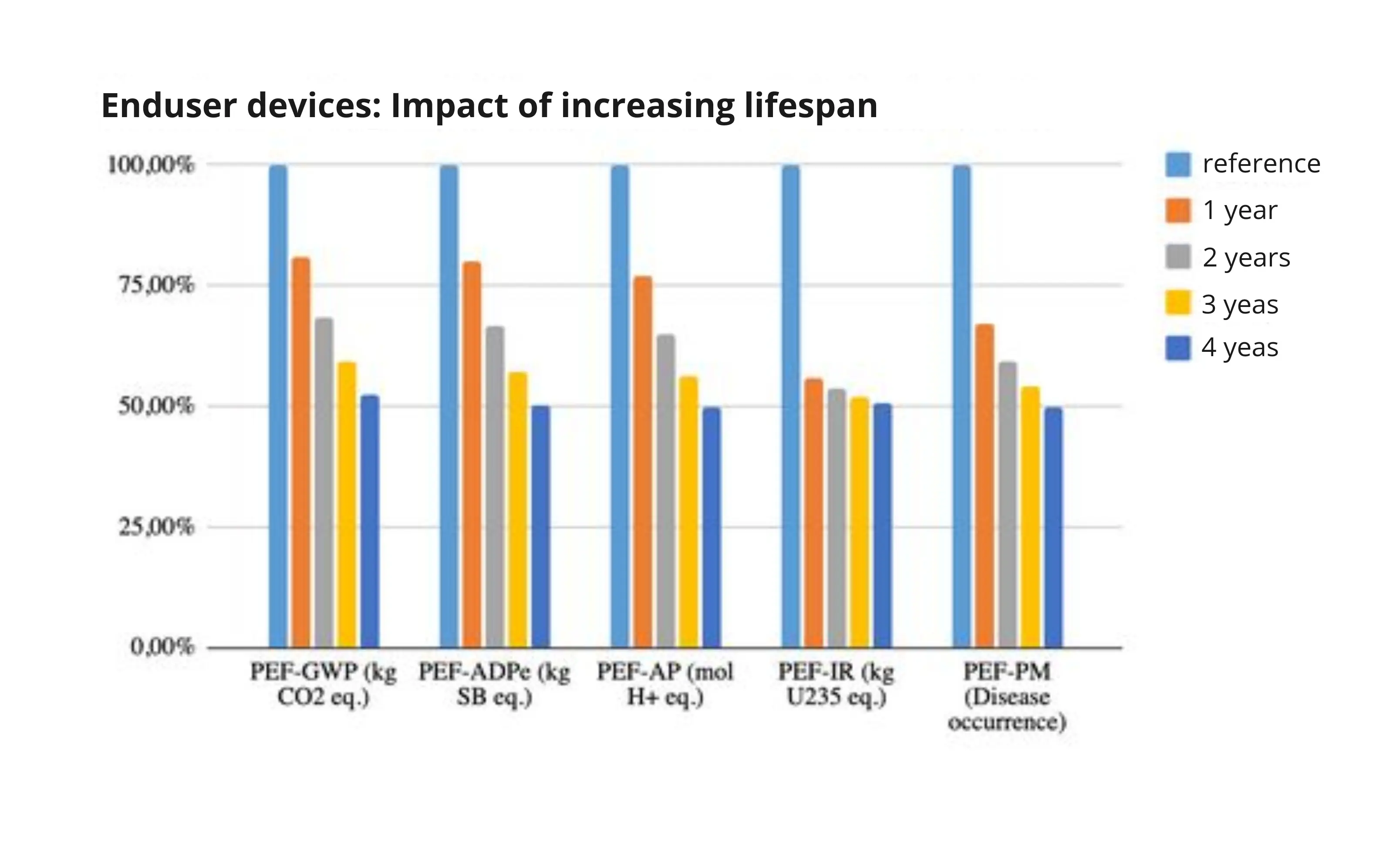
Although this approach offers a quantitative view of the potential gains enabled by an eco-design lever, it is very limited in the dynamics included in the analysis. For this reason, we took a complementary qualitative approach, following a long-term consequential approach materialized by consequence graphs. Below, the consequence graph linked to the lever of backward compatibility shows the consequences on the renewal rate of devices (and their lifespan) as in the attributional approach. It also shows the direct and indirect rebound effects of reallocating the savings made by not renewing a device. It also reveals the external factors that influence the identified consequences. Here, we show that Iroco has to work both against psychological obsolescence, which is one of the main causes of short terminal lifespan, and in concert with other service providers that also influence device renewal.

Special cases
Theoretically, the attributional and consequential paradigms yield the same results if the environmental impacts considered are linearly related to the functional unit under consideration. In other words, if implementing the same FU always leads to equal environmental consequences, these consequences can be assessed with either approach. This is true since, in a linear function, average impacts are equal to marginal impacts. A mathematical demonstration can be found here 10.
Take, for example, the assessment of particulate matter emitted by a thermal combustion engine for the FU "driving 1 km in a thermal car at 100km/h". In an attributional approach, it would be necessary to integrate the entire life cycle, from the manufacture of the car to the road infrastructure. In this example, we consider only the use phase to illustrate our point.
In this situation, we can consider that the linearity condition is satisfied, since combustion and particulate matter emissions are linearly related to the distance traveled defined in the FU. In this case, the attributional and consequential methods should provide similar results.
In reality, many parameters have a non-linear influence on a car's particulate matter emissions, such as engine temperature, road characteristics and driving style. As a result, the linearity condition is rarely observed, especially in the context of digital services. When an attributional paradigm is used to approach a consequential question, it should therefore be noted that linearity between impacts and FU is assumed, i.e. a phenomenon that is not necessarily linear is approximated by a linear function.
Conclusion
None of these three paradigms (attributional, short- and long-term consequential) is intrinsically more valid than another, and none is by definition more certain than another, since they each answer different questions, as we have seen.
The attributional approach tends to standardize the inclusion of resources by tracking physical flows and allocation rules. However, this standardization conceals many subjective and even political choices. On the other hand, the consequential approach is supposed to describe an environmental reality resulting from physical and socio-economic transformations. However, determining the consequences of an action, as well as what would have happened without that action, is a highly uncertain process that also relies on a number of political choices. For example, the long-term consequences of electricity consumption depend on the nature of the electricity production infrastructures that will be deployed in the future, and therefore on our energy policy.
We have identified a complementarity between the attributional and consequential long-term approaches. While the former is suitable for establishing the "responsibilities" of a service and its value chain, in particular in relation to existing infrastructures, the consequential approach enables us to project into the future and reflect on the positive and negative environmental consequences of the changes made by the service. In the digital sector, the short-term consequential approach is not very relevant, as environmental impacts are not so much linked, in the short term, to usage as to infrastructure.
Whatever approach is used, we believe it needs to be informed by the question to be answered, the data available and the means at our disposal. Our study of the archetypal case of e-mail, carried out with Iroco, shows that these approaches complement each other in guiding the design of digital services, particularly attributional and long-term consequential approaches.
| Method | Attributional | Consequential | |
| Short-term | Long-term | ||
| Theoretical question | What share of the total impacts of my system can be attributed to the Functional Unit? | What is the environmental impact induced by the implementation of the FU? | |
| What is the difference in the share of environmental impacts from the technosphere attributable to FU for each of the levers implemented? | What is the difference in environmental impact induced by the implementation of the FU for each of the levers implemented? | What is the impact of generalizing each of these levers? | |
| Objective | Identify environmental responsibilities associated with the FU | Identify impacts directly induced by FU implementation | Identify the impacts directly and indirectly induced by the implementation of the FU |
| Impacts of existing infrastructures | YES | NO | NO |
| Impacts of new infrastructures | Depends on circumstances | NO | YES |
| Inclusion of environmental impacts | By following physical links (energy, matter) | Tracking the physical and economic consequences of implementing the FU with constant infrastructure | Tracking the physical and socio-economic consequences of implementing the FU |
| Effect types | Directs | Direct and some indirect effects | Direct & Indirect |
| Relevance for ICT | Strong | Low | Very strong |
Notes
Sources cited in this article :
Dans le cas d’une approche conséquentielle sur un changement passé, on inclura des conséquences passées, mais qui restent postérieures à la mise en œuvre initiale du service considéré.
Jens Malmodin (Ericsson), 2020, Fraunhofer IZM, www.electronicsgoesgreen.org 87ISBN 978-3-8396-1659-8 Electronics Goes Green 2020+
Jens Malmodin (Ericsson), 2020, Fraunhofer IZM, www.electronicsgoesgreen.org 87ISBN 978-3-8396-1659-8 Electronics Goes Green 2020+
Isabelle Blanc. EcoSD Annual Workshop - Consequential LCA. Annual Workshop Consequential LCA, Mar 2013, Rueil Malmaison, France. Presses des Mines, 88 p., 2015, Collection Développement durable, 978-2-35671-149-6. hal-01110162, Some fundamentals on ALCA and CLCA_
hubblo